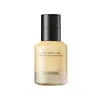What's inside
What's inside
 Key Ingredients
Key Ingredients

 Benefits
Benefits

 Concerns
Concerns

 Ingredients Side-by-side
Ingredients Side-by-side

Water
Skin ConditioningDipropylene Glycol
HumectantAlcohol Denat.
AntimicrobialNiacinamide
SmoothingBetaine
HumectantGlycerin
Humectant1,2-Hexanediol
Skin ConditioningPolyglyceryl-10 Stearate
Skin ConditioningGlycereth-26
HumectantPolyurethane-15
Propanediol
SolventCetearyl Alcohol
EmollientTromethamine
BufferingCarbomer
Emulsion StabilisingHydroxyethylcellulose
Emulsion StabilisingCeramide NP
Skin ConditioningAcrylates/C10-30 Alkyl Acrylate Crosspolymer
Emulsion StabilisingTriethylhexanoin
MaskingButylene Glycol
HumectantAdenosine
Skin ConditioningLactobacillus
Skin ConditioningSqualane
EmollientSaccharomyces/Potato Extract Ferment Filtrate
HumectantSaccharomyces/Coix Lacryma-Jobi Ma-Yuen Seed Ferment Filtrate
Skin ConditioningPhospholipids
Skin ConditioningLactobacillus/Soybean Ferment Extract
Skin ConditioningLactobacillus/Rice Ferment
Skin ConditioningHydrogenated Polydecene
EmollientDisodium EDTA
Calcium Titanium Borosilicate
AbrasiveCholesterol
EmollientPhytosphingosine
Skin ConditioningHydrogenated Lecithin
EmulsifyingTheobroma Cacao Extract
Skin ConditioningAquilaria Agallocha Wood Extract
Skin ConditioningGardenia Florida Flower Extract
Skin ConditioningTin Oxide
AbrasiveIron Oxides
CI 77491
Cosmetic ColorantCI 19140
Cosmetic ColorantDextrin
AbsorbentCI 77891
Cosmetic ColorantParfum
MaskingLimonene
PerfumingCitronellol
PerfumingGeraniol
PerfumingLinalool
PerfumingWater, Dipropylene Glycol, Alcohol Denat., Niacinamide, Betaine, Glycerin, 1,2-Hexanediol, Polyglyceryl-10 Stearate, Glycereth-26, Polyurethane-15, Propanediol, Cetearyl Alcohol, Tromethamine, Carbomer, Hydroxyethylcellulose, Ceramide NP, Acrylates/C10-30 Alkyl Acrylate Crosspolymer, Triethylhexanoin, Butylene Glycol, Adenosine, Lactobacillus, Squalane, Saccharomyces/Potato Extract Ferment Filtrate, Saccharomyces/Coix Lacryma-Jobi Ma-Yuen Seed Ferment Filtrate, Phospholipids, Lactobacillus/Soybean Ferment Extract, Lactobacillus/Rice Ferment, Hydrogenated Polydecene, Disodium EDTA, Calcium Titanium Borosilicate, Cholesterol, Phytosphingosine, Hydrogenated Lecithin, Theobroma Cacao Extract, Aquilaria Agallocha Wood Extract, Gardenia Florida Flower Extract, Tin Oxide, Iron Oxides, CI 77491, CI 19140, Dextrin, CI 77891, Parfum, Limonene, Citronellol, Geraniol, Linalool
Hydrogenated Polydecene
EmollientHydrogenated Polyisobutene
EmollientRicinus Communis Seed Oil
MaskingEthylene/Propylene Copolymer
AbrasiveEthylhexyl Olivate
Skin ConditioningPolyglyceryl-4 Diisostearate/Polyhydroxystearate/Sebacate
EmulsifyingParfum
MaskingCaprylyl Glycol
EmollientDiisostearyl Malate
EmollientArgania Spinosa Kernel Oil
EmollientOctyldodecyl Stearoyl Stearate
EmollientEthylhexylglycerin
Skin ConditioningPersea Gratissima Oil
Skin ConditioningCI 77891
Cosmetic Colorant1,2-Hexanediol
Skin ConditioningCI 77007
Cosmetic ColorantCI 77491
Cosmetic ColorantHydrolyzed Hyaluronic Acid
HumectantHydrogenated Polydecene, Hydrogenated Polyisobutene, Ricinus Communis Seed Oil, Ethylene/Propylene Copolymer, Ethylhexyl Olivate, Polyglyceryl-4 Diisostearate/Polyhydroxystearate/Sebacate, Parfum, Caprylyl Glycol, Diisostearyl Malate, Argania Spinosa Kernel Oil, Octyldodecyl Stearoyl Stearate, Ethylhexylglycerin, Persea Gratissima Oil, CI 77891, 1,2-Hexanediol, CI 77007, CI 77491, Hydrolyzed Hyaluronic Acid
Alternatives
Ingredients Explained
These ingredients are found in both products.
Ingredients higher up in an ingredient list are typically present in a larger amount.
1,2-Hexanediol is a synthetic liquid and another multi-functional powerhouse.
It is a:
- Humectant, drawing moisture into the skin
- Emollient, helping to soften skin
- Solvent, dispersing and stabilizing formulas
- Preservative booster, enhancing the antimicrobial activity of other preservatives
Ci 77491 is also hydrated iron III oxide. It's sole purpose is to give a red/pink hue to products.
Iron III oxides are classified as inorganic chemicals for coloring.
Synthetically created Ci 77491 is considered safer than those naturally found. This is because the synthetically created version may contain less impurities. Iron oxides are generally non-toxic and non-allergenic.
Learn more about CI 77491Ci 77891 is a white pigment from Titanium dioxide. It is naturally found in minerals such as rutile and ilmenite.
It's main function is to add a white color to cosmetics. It can also be mixed with other colors to create different shades.
Ci 77891 is commonly found in sunscreens due to its ability to block UV rays.
Learn more about CI 77891Hydrogenated Polydecene is an emollient. It creates a non-occlusive film on the skin that offers extra protection for your skin barrier.
The texture of Hydrogenated Polydecene ranges from light and silky to rich.
Hydrogenated Polydecene is the end compound of controlled hydrogenation of Polydecene.
Learn more about Hydrogenated PolydeceneParfum is a catch-all term for an ingredient or more that is used to give a scent to products.
Also called "fragrance", this ingredient can be a blend of hundreds of chemicals or plant oils. This means every product with "fragrance" or "parfum" in the ingredients list is a different mixture.
For instance, Habanolide is a proprietary trade name for a specific aroma chemical. When used as a fragrance ingredient in cosmetics, most aroma chemicals fall under the broad labeling category of “FRAGRANCE” or “PARFUM” according to EU and US regulations.
The term 'parfum' or 'fragrance' is not regulated in many countries. In many cases, it is up to the brand to define this term.
For instance, many brands choose to label themselves as "fragrance-free" because they are not using synthetic fragrances. However, their products may still contain ingredients such as essential oils that are considered a fragrance by INCI standards.
One example is Calendula flower extract. Calendula is an essential oil that still imparts a scent or 'fragrance'.
Depending on the blend, the ingredients in the mixture can cause allergies and sensitivities on the skin. Some ingredients that are known EU allergens include linalool and citronellol.
Parfum can also be used to mask or cover an unpleasant scent.
The bottom line is: not all fragrances/parfum/ingredients are created equally. If you are worried about fragrances, we recommend taking a closer look at an ingredient. And of course, we always recommend speaking with a professional.
Learn more about Parfum